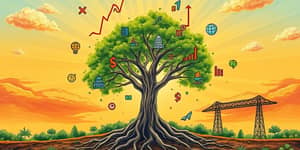
In a world shaped by shifting markets and global events, mastering the rhythm of economic cycles is essential. Just as mariners rely on an anchor to stay grounded in stormy seas, individuals and businesses need a stable financial strategy for turbulent times. By understanding the patterns of expansion, peak, contraction, and recovery, you can chart a course that weathers downturns and leverages upswings.
From short-lived business cycles to sprawling supercycles, these waves influence every corner of the economy. Recognizing them not only provides insight into policy decisions and market trends but also empowers you to make informed choices with greater confidence. This guide unpacks the theory, data, and practical steps to turn uncertainty into opportunity.
Economic cycles are recurring fluctuations in activity, driven by shifts in production, consumption, and investment. Scholars identify four primary cycles: the Kitchin (3–5 years), Juglar (7–11 years), Kuznets (15–25 years), and the Kondratiev wave (45–60 years). Each cycle carries its own tempo and impact, influencing GDP growth, unemployment rates, and inflation dynamics.
The Kondratiev waves, often called “supercycles,” span decades and coincide with major technological revolutions—from the steam engine to the information age. We currently find ourselves in a descending wave marked by slower productivity growth and global headwinds, but history tells us that downturns give rise to innovation and renewal.
The postwar era offers clear markers of long-wave trends. From 1950 to 1973, global GDP and productivity surged during an ascending Kondratiev wave. The period from 1974 to 1995 saw a descent, with stagflation and deep recessions. A resurgence followed between 1996 and 2010, led by rapid digitalization and an average annual growth rate of labor productivity at 2.7% in the U.S.
Since 2011, the global economy has entered another descending phase, with labor productivity growth slowing to 0.9%. The COVID-19 pandemic triggered a sharp contraction in 2020—global real GDP fell by 4.9%, advanced economies dropped 8%, and developing nations declined 3%. Yet forecasts suggest a new ascending wave from 2026 to 2040, driven by innovations in nanotechnology, renewable energy, and digital ecosystems.
At the core of every long wave lies a technological revolution. From the mechanization of agriculture to the dawn of the internet, each leap shifts production methods, consumer behavior, and capital flows. Emerging frontiers—such as the Internet of Things, advanced biotech, and sustainable energy—are poised to ignite the next supercycle.
Global competition and accelerated innovation have also shortened cycle durations. Scholars note that new waves may be briefer yet more intense, as ideas and capital move faster than ever. Understanding these drivers helps you anticipate shifts and align your strategy with the cutting edge of progress.
Amidst these monumental forces, individuals and businesses need concrete steps to maintain stability. A diversified portfolio acts as your first line of defense, spreading risk and smoothing returns through ups and downs. Coupled with an emergency fund and prudent debt management, you establish a foundation that resists panic and positions you for growth.
Timing the market is tempting but perilous. Instead, focus on consistency and resilience. By aligning your decisions with historical patterns, you avoid reactionary moves and secure gains over the long haul.
As we edge toward 2026, keep an eye on emerging technologies and global policy shifts. Nations investing in renewable energy, digital infrastructure, and education are likely to lead the next expansion. By aligning your portfolio and skills with these frontiers, you position yourself at the crest of the coming wave rather than trailing in its wake.
History is rife with cautionary tales—from the Great Depression to the dot-com crash—and with inspiring recoveries. Those who endured past recessions relied on a blend of discipline, forward planning, and opportunism. Embrace their example by maintaining long-term perspective, learning from downturns, and treating challenges as springboards for innovation.
Economic waves may feel unpredictable, but they follow time-tested patterns shaped by technology, demographics, and policy. By understanding these cycles and adopting stable financial strategies in volatile markets, you transform uncertainty into a source of strength. Equip yourself with knowledge, diversify intelligently, and hold fast to your anchor—then watch as each wave carries you to new horizons.
References













